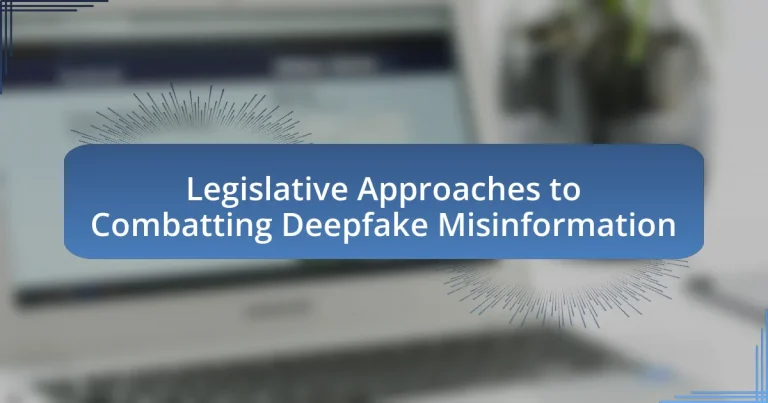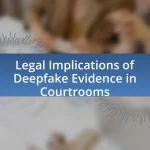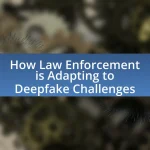The article focuses on legislative approaches to combat deepfake misinformation, highlighting the necessity of enacting laws that criminalize the malicious use of deepfakes and establish transparency requirements for digital content. It discusses various legislative measures being implemented in jurisdictions such as California and Texas, as well as proposed regulations like the DEEPFAKES Accountability Act. The article also examines the potential harms caused by deepfake misinformation, the challenges existing legal frameworks face, and the importance of international cooperation in addressing these issues. Additionally, it outlines best practices for effective legislation and the role of public engagement and technology companies in shaping future laws.
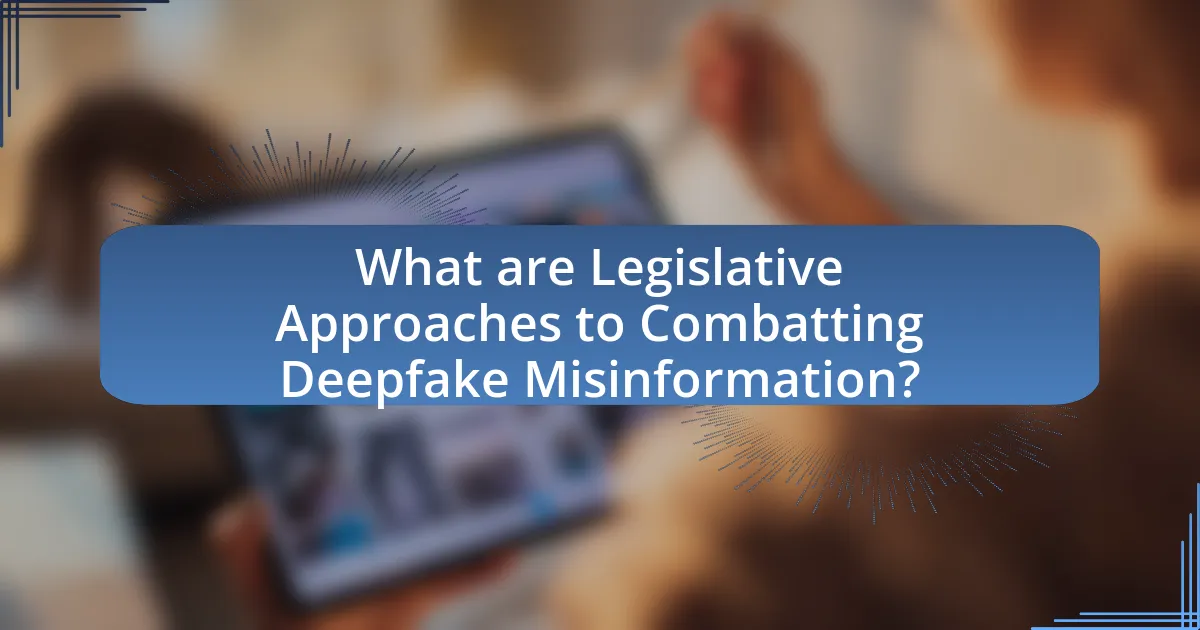
What are Legislative Approaches to Combatting Deepfake Misinformation?
Legislative approaches to combatting deepfake misinformation include enacting laws that criminalize the malicious use of deepfakes, establishing transparency requirements for digital content, and promoting public awareness campaigns. For instance, several U.S. states, such as California and Texas, have passed laws specifically targeting the use of deepfakes in ways that can harm individuals or manipulate elections. These laws often impose penalties for creating or distributing deepfakes without clear labeling, thereby aiming to deter misuse. Additionally, the proposed DEEPFAKES Accountability Act seeks to require platforms to disclose the use of deepfake technology, enhancing accountability and consumer awareness. Such legislative measures are essential in addressing the growing threat of deepfake misinformation, as they provide a legal framework to hold offenders accountable and protect the public from deceptive content.
Why is legislation necessary to address deepfake misinformation?
Legislation is necessary to address deepfake misinformation because it establishes legal frameworks that deter the creation and distribution of harmful deepfakes. Without laws, individuals and organizations may exploit deepfake technology to manipulate public perception, spread false information, and undermine trust in media. For instance, a study by the Brookings Institution found that deepfakes can significantly influence public opinion and electoral processes, highlighting the urgent need for regulatory measures to protect democratic integrity. Legislation can also provide victims of deepfake misinformation with legal recourse, thereby promoting accountability and reducing the prevalence of such deceptive practices.
What are the potential harms caused by deepfake misinformation?
Deepfake misinformation can cause significant harm by undermining trust in media and institutions. This technology can create realistic but fabricated videos that misrepresent individuals, leading to reputational damage, emotional distress, and potential legal consequences for those depicted. For instance, a study by the University of California, Berkeley, found that deepfakes can influence public opinion and voter behavior, as seen in manipulated political videos that mislead viewers. Additionally, deepfakes can facilitate fraud, harassment, and the spread of false narratives, contributing to societal polarization and misinformation.
How does deepfake technology challenge existing legal frameworks?
Deepfake technology challenges existing legal frameworks by creating realistic yet fabricated content that can mislead individuals and manipulate public perception. Traditional laws regarding defamation, copyright, and privacy are often inadequate to address the unique issues posed by deepfakes, as these laws were not designed to handle the rapid advancements in digital manipulation. For instance, the U.S. legal system struggles with defining the ownership and consent issues surrounding the use of someone’s likeness in deepfake videos, leading to potential violations of personal rights without clear legal recourse. Additionally, the difficulty in proving intent and harm in cases involving deepfakes complicates the enforcement of existing laws, as seen in various legal cases where victims have found it challenging to seek justice.
What types of legislative measures are being proposed or implemented?
Various legislative measures are being proposed and implemented to combat deepfake misinformation, including laws that mandate labeling of synthetic media, regulations that impose penalties for malicious use of deepfakes, and initiatives aimed at enhancing digital literacy among the public. For instance, the U.S. states of California and Texas have enacted laws that criminalize the use of deepfakes for malicious purposes, such as defamation or fraud. Additionally, the European Union has proposed regulations that require platforms to take responsibility for the content they host, which includes addressing deepfake technology. These measures reflect a growing recognition of the need to address the potential harms posed by deepfake misinformation in the digital landscape.
What are the key components of proposed deepfake legislation?
The key components of proposed deepfake legislation include definitions of deepfakes, requirements for disclosure, penalties for malicious use, and provisions for law enforcement. Definitions clarify what constitutes a deepfake, ensuring legal clarity. Disclosure requirements mandate that creators label deepfake content to inform viewers. Penalties are established to deter malicious use, often including fines or imprisonment for those who create harmful deepfakes. Provisions for law enforcement empower authorities to investigate and prosecute violations effectively, addressing the growing concern over misinformation and its impact on society.
How do different jurisdictions approach deepfake regulation?
Different jurisdictions approach deepfake regulation through a combination of existing laws and new legislation tailored to address the unique challenges posed by deepfakes. For instance, the United States has seen states like California and Texas enact specific laws targeting deepfake technology, focusing on issues such as consent and fraud. In contrast, the European Union is working on comprehensive regulations under the Digital Services Act, which aims to hold platforms accountable for harmful content, including deepfakes. Additionally, countries like Australia have proposed amendments to existing laws to include provisions specifically addressing deepfake misuse, particularly in relation to defamation and privacy rights. These varied approaches reflect the jurisdictions’ recognition of the potential harms of deepfakes and their commitment to developing legal frameworks that can effectively mitigate these risks.
What role do international agreements play in combatting deepfake misinformation?
International agreements play a crucial role in combatting deepfake misinformation by establishing a framework for cooperation among nations to address the challenges posed by this technology. These agreements facilitate the sharing of best practices, legal standards, and technological solutions to identify and mitigate the impact of deepfakes on society. For instance, the G7’s commitment to countering disinformation includes specific references to the dangers of deepfakes, highlighting the need for collaborative efforts to enhance media literacy and develop detection tools. Such international cooperation is essential, as deepfake technology transcends borders, requiring a unified response to effectively combat its misuse.
How can global cooperation enhance legislative efforts against deepfakes?
Global cooperation can enhance legislative efforts against deepfakes by facilitating the sharing of best practices, legal frameworks, and technological advancements among countries. Collaborative initiatives, such as international treaties or agreements, can establish standardized definitions and regulations for deepfake technology, making it easier to address cross-border issues. For instance, the European Union’s Digital Services Act aims to create a safer digital space by holding platforms accountable for harmful content, which can serve as a model for other nations. Additionally, joint research and development projects can lead to improved detection technologies, enabling lawmakers to craft more effective legislation.
What are the challenges of enforcing international laws on deepfakes?
Enforcing international laws on deepfakes faces significant challenges due to jurisdictional issues, technological complexity, and the rapid evolution of deepfake technology. Jurisdictional issues arise because deepfakes can be created and disseminated across borders, complicating the enforcement of laws that vary by country. Technological complexity makes it difficult for law enforcement to identify and attribute deepfake content accurately, as the tools used to create deepfakes are often accessible to the public. Furthermore, the rapid evolution of deepfake technology outpaces legislative efforts, making existing laws potentially obsolete before they can be effectively implemented. These factors collectively hinder the establishment of a cohesive international legal framework to address deepfake misinformation.
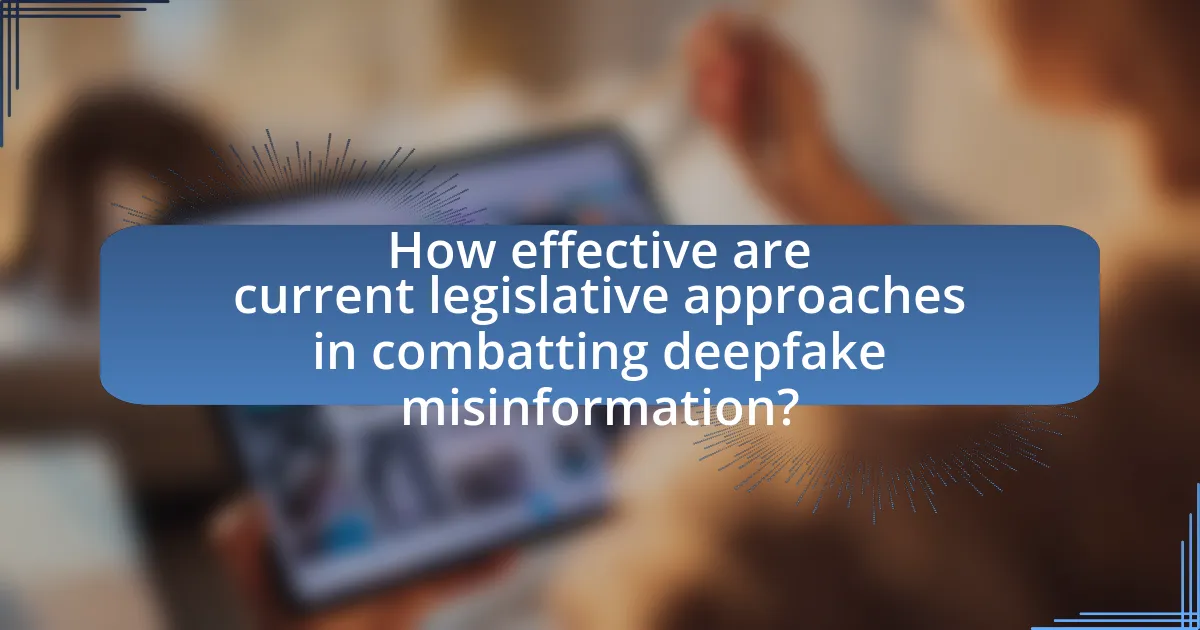
How effective are current legislative approaches in combatting deepfake misinformation?
Current legislative approaches are moderately effective in combatting deepfake misinformation. Various jurisdictions have enacted laws targeting the creation and distribution of deepfakes, such as California’s AB 730, which criminalizes the malicious use of deepfakes for purposes like defamation or fraud. However, the effectiveness is limited by challenges such as the rapid evolution of technology, jurisdictional issues, and the difficulty in proving intent behind the creation of deepfakes. Additionally, a report from the Brookings Institution highlights that while legislation can deter some malicious actors, it often lacks the resources for enforcement and may not keep pace with the sophistication of deepfake technology.
What metrics can be used to evaluate the effectiveness of deepfake legislation?
Metrics to evaluate the effectiveness of deepfake legislation include the reduction in reported incidents of deepfake-related harm, the number of successful prosecutions under the legislation, and public awareness levels regarding deepfake technology and its legal implications. A decrease in incidents indicates that the legislation is deterring misuse, while successful prosecutions demonstrate enforcement efficacy. Additionally, surveys measuring public awareness can reflect the legislation’s impact on educating citizens about the risks associated with deepfakes and their legal rights.
How do we measure public awareness and understanding of deepfake laws?
Public awareness and understanding of deepfake laws can be measured through surveys and public opinion polls that assess knowledge and perceptions of these regulations. For instance, a study conducted by the Pew Research Center in 2020 found that 51% of Americans had heard of deepfakes, indicating a baseline level of awareness. Additionally, focus groups can provide qualitative insights into how individuals interpret and understand the implications of deepfake legislation. Analyzing social media discussions and engagement metrics can also reveal public sentiment and comprehension regarding deepfake laws, as demonstrated by research from the Digital Civil Society Lab, which highlighted the role of online discourse in shaping public understanding of emerging technologies.
What case studies illustrate the impact of legislation on deepfake incidents?
Case studies illustrating the impact of legislation on deepfake incidents include California’s AB 730, which criminalizes the malicious use of deepfakes for harassment or defamation, leading to a decrease in reported incidents of such misuse. Additionally, the UK’s Online Safety Bill aims to regulate harmful content, including deepfakes, resulting in increased accountability for platforms hosting such material. These legislative measures have prompted tech companies to enhance their detection technologies and policies, demonstrating a tangible effect on the prevalence of deepfake-related harms.
What are the limitations of existing legislative frameworks?
Existing legislative frameworks face significant limitations in effectively addressing deepfake misinformation. These frameworks often lack specificity regarding the definition and classification of deepfakes, leading to ambiguity in enforcement. For instance, many laws are outdated and do not account for the rapid technological advancements in artificial intelligence and media manipulation. Additionally, existing regulations may not adequately address the cross-jurisdictional nature of deepfake distribution, complicating legal responses. Furthermore, enforcement mechanisms are often weak, with insufficient resources allocated for monitoring and prosecuting violations. Studies indicate that only a small percentage of deepfake cases result in legal action, highlighting the ineffectiveness of current laws in deterring misuse.
How do technological advancements outpace legislative responses?
Technological advancements outpace legislative responses due to the rapid development and deployment of new technologies that often exceed the speed at which laws can be formulated and enacted. For instance, the emergence of deepfake technology has advanced significantly since its inception, with tools becoming widely accessible and sophisticated within a few years. In contrast, legislative bodies typically require extensive deliberation, public input, and consensus-building, which can take months or years. As a result, laws addressing deepfake misinformation lag behind the technology, leaving gaps in regulation and enforcement. This discrepancy is evident in the fact that many jurisdictions still lack comprehensive legal frameworks specifically targeting the misuse of deepfakes, despite the technology being available for public use since around 2017.
What gaps exist in current laws regarding deepfake accountability?
Current laws regarding deepfake accountability lack comprehensive definitions and specific regulations targeting the creation and distribution of deepfakes. Many jurisdictions do not have explicit legal frameworks that address the malicious use of deepfakes, leading to challenges in prosecuting offenders. For instance, existing laws often rely on traditional fraud or defamation statutes, which may not adequately cover the unique aspects of deepfake technology. Additionally, there is a lack of international consensus on standards for deepfake regulation, resulting in inconsistent enforcement across borders. This gap in legislation allows for the potential misuse of deepfakes in various contexts, including misinformation campaigns and identity theft, without clear legal repercussions.
What are the implications of ineffective legislation on society?
Ineffective legislation on society can lead to increased misinformation and erosion of public trust. When laws fail to adequately address issues like deepfake technology, they allow the proliferation of false information, which can manipulate public opinion and influence elections. For instance, a study by the Stanford Internet Observatory found that deepfakes can significantly impact political discourse, leading to confusion and distrust among voters. Additionally, ineffective laws can result in a lack of accountability for creators of harmful content, further exacerbating societal divisions and undermining democratic processes.
How does misinformation from deepfakes affect public trust in media?
Misinformation from deepfakes significantly undermines public trust in media by creating doubt about the authenticity of visual content. Research indicates that as deepfake technology becomes more sophisticated, audiences struggle to discern real from manipulated media, leading to skepticism towards legitimate news sources. A study published in the journal “Media Psychology” found that exposure to deepfakes can decrease trust in media outlets by up to 30%, as individuals become more likely to question the credibility of all media, regardless of its authenticity. This erosion of trust complicates the media landscape, making it essential for legislative measures to address the challenges posed by deepfake misinformation.
What are the potential consequences for democracy and elections?
The potential consequences for democracy and elections include erosion of public trust, manipulation of voter perceptions, and undermining of electoral integrity. Deepfake misinformation can mislead voters by creating false narratives or altering the appearance of candidates, which can influence election outcomes. For instance, a study by the Stanford Internet Observatory found that deepfakes can significantly sway public opinion, demonstrating their potential to disrupt democratic processes. Additionally, the proliferation of such misinformation can lead to increased polarization and decreased civic engagement, further threatening the foundational principles of democracy.
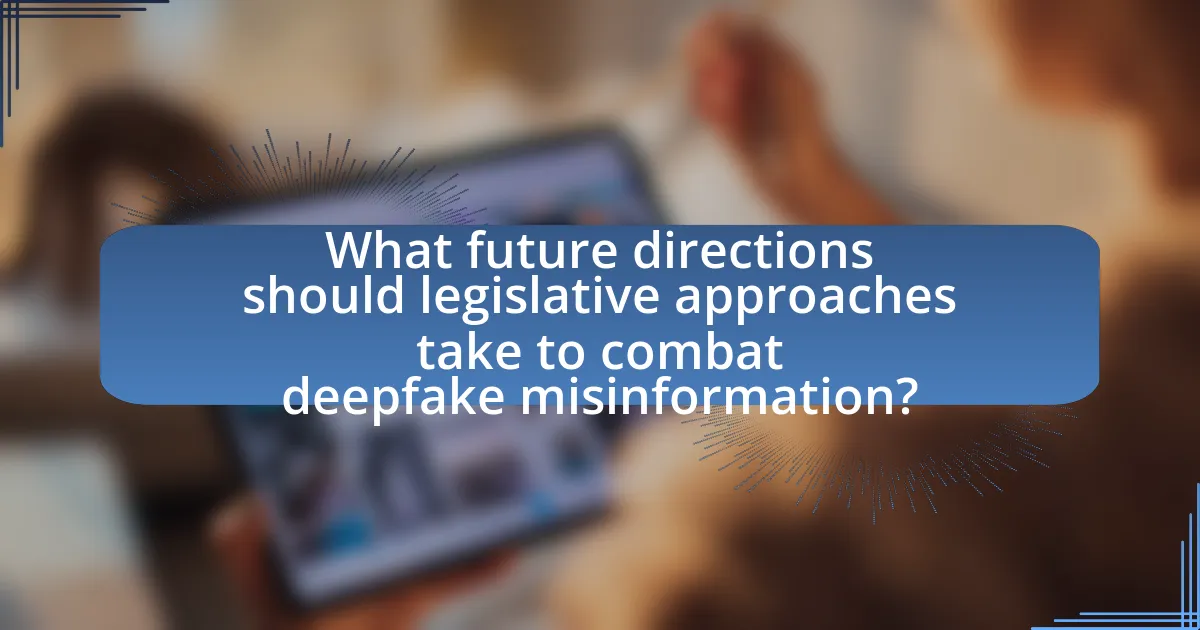
What future directions should legislative approaches take to combat deepfake misinformation?
Legislative approaches should focus on establishing clear definitions and legal frameworks for deepfakes to effectively combat misinformation. This includes creating laws that specifically address the creation, distribution, and use of deepfakes, ensuring accountability for malicious actors. For instance, jurisdictions like California have already enacted laws targeting deepfake technology in the context of elections and pornography, demonstrating the feasibility of such measures. Furthermore, future legislation should incorporate penalties for the malicious use of deepfakes, as well as provisions for transparency, requiring platforms to label or remove deceptive content. This approach is supported by research indicating that clear legal consequences can deter the misuse of technology, thereby protecting public discourse and trust in media.
How can lawmakers adapt to the evolving nature of deepfake technology?
Lawmakers can adapt to the evolving nature of deepfake technology by implementing comprehensive regulations that address the creation and distribution of deepfakes. These regulations should include clear definitions of deepfakes, establish legal consequences for malicious use, and promote transparency in media. For instance, California’s AB 730 law, enacted in 2019, criminalizes the use of deepfakes to harm others, demonstrating a legislative response to the technology’s potential for misuse. Additionally, lawmakers can collaborate with technology experts to stay informed about advancements in deepfake capabilities, ensuring that laws remain relevant and effective. This proactive approach is essential to mitigate the risks associated with deepfake misinformation and protect public trust in media.
What role should technology companies play in legislative discussions?
Technology companies should actively participate in legislative discussions to provide expertise and insights on the implications of deepfake technology. Their involvement is crucial because they possess the technical knowledge necessary to inform lawmakers about the capabilities and limitations of deepfake creation and detection. For instance, companies like Facebook and Google have previously engaged in discussions regarding misinformation, highlighting the need for regulations that balance innovation with public safety. This collaboration can lead to more effective policies that address the challenges posed by deepfakes while fostering a responsible technological environment.
How can public engagement shape future legislation on deepfakes?
Public engagement can significantly shape future legislation on deepfakes by influencing policymakers through collective awareness and advocacy. When the public actively participates in discussions about the risks and ethical implications of deepfakes, it creates pressure on legislators to address these concerns in law. For instance, public campaigns and petitions have previously led to the introduction of regulations in other areas of technology, such as data privacy laws following widespread concern over data breaches. Additionally, feedback from community forums and social media can provide lawmakers with insights into public sentiment, guiding them to craft legislation that reflects the values and needs of their constituents. This dynamic interaction between the public and legislators ensures that laws are not only reactive but also proactive in addressing emerging challenges posed by deepfake technology.
What best practices can be adopted for effective legislation against deepfakes?
Effective legislation against deepfakes should incorporate clear definitions, accountability measures, and technological standards. Clear definitions of what constitutes a deepfake are essential to avoid ambiguity in legal contexts, as seen in California’s law that specifically defines manipulated media. Accountability measures should include penalties for malicious use of deepfakes, which can deter potential offenders; for instance, laws in the UK impose fines for harmful deepfake creation. Additionally, establishing technological standards for labeling deepfakes can help inform the public and mitigate misinformation, similar to initiatives by social media platforms that flag manipulated content. These best practices create a comprehensive framework for addressing the challenges posed by deepfakes.
How can collaboration between stakeholders enhance legislative outcomes?
Collaboration between stakeholders enhances legislative outcomes by fostering diverse perspectives and expertise, which leads to more comprehensive and effective policies. When various stakeholders, including government agencies, technology companies, civil society organizations, and academia, work together, they can identify potential challenges and solutions related to deepfake misinformation more effectively. For instance, a study by the Berkman Klein Center for Internet & Society at Harvard University highlights that multi-stakeholder engagement can improve the understanding of technological implications and societal impacts, resulting in legislation that is better informed and more adaptable to rapid changes in technology. This collaborative approach not only increases the legitimacy of the legislative process but also encourages broader public support and compliance, ultimately leading to more successful implementation of laws aimed at combatting deepfake misinformation.
What lessons can be learned from other areas of misinformation regulation?
Lessons from other areas of misinformation regulation indicate that a multi-faceted approach is essential for effective governance. For instance, the regulation of tobacco advertising has shown that clear labeling and public awareness campaigns can significantly reduce harmful behaviors. Similarly, the regulation of online hate speech demonstrates that proactive monitoring and community guidelines can help mitigate the spread of harmful content. These examples highlight the importance of transparency, public education, and collaboration between stakeholders, including technology platforms and regulatory bodies, to create a comprehensive framework that addresses misinformation effectively.
What practical steps can individuals take to navigate deepfake misinformation?
Individuals can navigate deepfake misinformation by verifying the authenticity of content through fact-checking websites and tools designed to detect manipulated media. Utilizing resources like Snopes or FactCheck.org allows individuals to cross-reference claims and assess the credibility of videos or images. Additionally, individuals should scrutinize the source of the content, considering the reputation and reliability of the platform where it is published. Engaging with media literacy programs can enhance critical thinking skills, enabling individuals to discern between genuine and altered content. Research indicates that awareness and education significantly reduce the impact of misinformation, as informed individuals are less likely to share unverified content.
